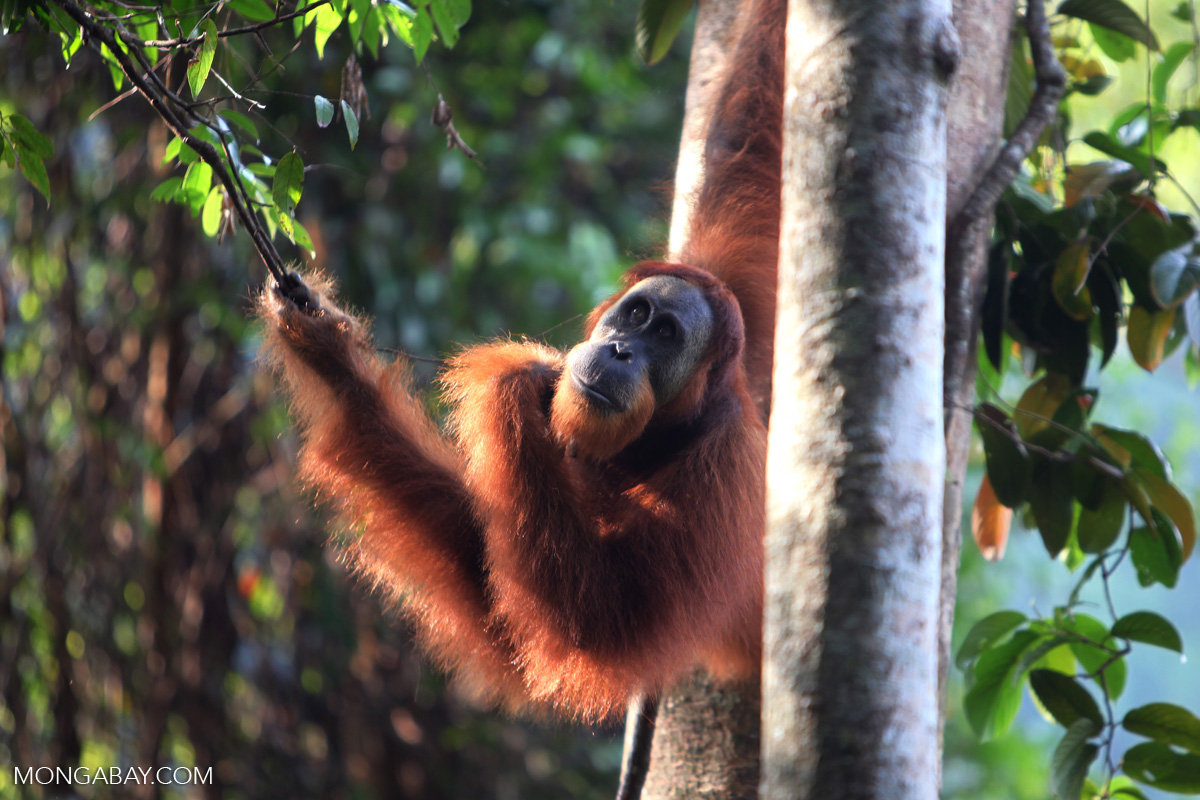- An international team of researchers estimates the total number of Sumatran orangutan to be close to 14,600 – over twice as many as the previously accepted count of 6,600.
- The group used a series of nest decay surveys to estimate densities across the Indonesian island.
- They found individuals in new areas once thought devoid of orangutans, consistently encountered them at higher elevations, and found populations in degraded forests not included in earlier studies.
There may be more orangutans in Sumatra than we thought, but that is the only good news found in a paper published today in the journal Science Advances. The authors also write that habitat loss and poaching will continue to cause steep declines in the population of this Critically Endangered great ape.
An international team of researchers, lead by Serge Wich of Liverpool John Moores University, estimates the total number of Sumatran orangutan to be close to 14,600 – over twice as many as the previously accepted count of 6,600. The group used a series of nest decay surveys to estimate densities across the Indonesian island. They found individuals in new areas once thought devoid of orangutans, consistently encountered them at higher elevations, and found populations in degraded forests not included in earlier studies.
However, more important than the actual numbers is the density of animals found in different forest types. When the authors overlaid population estimates on current and future land-use maps, they re-confirmed that orangutan numbers will continue to decline rapidly as forests are degraded – likely suffering a 14-33% decrease over the next 15 years.
Sumatran orangutan densities are highest in peat swamp forests and lowland forests on mineral soils, the study finds, with lower densities found in degraded forest and in locations closer to human populations. As more roads are built and more forests logged or converted to agriculture, more orangutans will disappear.

“The fact that we see large areas of forest being converted to oil palm plantations and other land uses means that we are losing orangutans in those areas,” lead author Wich told Mongabay. And, although more individual orangutans exist than we thought, he said, “the decline is still very real.”
Ecologist and Director of Borneo Futures, Erik Meijaard puts the updated numbers in succinct perspective. “Our data on habitat loss and killing rates indicates a population decline of about 25% per decade,” Meijaard, who was not involved with this study, said. “If the population is 14,631 rather than 6,600, this means that in 100 years from now … there will be 823 orangutans left rather than 372. Either way the species is very close to extinction.”
The fact that orangutans have been found at higher elevations than expected is also important, but not necessarily a cause for optimism.
“We do not know if and how the orangutans in higher areas depend on lowland areas for food,” Wich said. “If there is a high dependency, then highland orangutans are at risk from deforestation in lowland areas as well.”

Ecologist Andrew Marshall, who studies primates in Kalimantan, echoed these concerns.
“We know almost nothing about orangutan populations at higher elevations,” Marshall told Mongabay, “Data from other Indonesian vertebrates, including gibbons, suggest that higher elevation forests may not be viable long-term habitat for many species. They may be used seasonally or occupied by small numbers of individuals, but are of insufficient quality to support stable populations in the absence of connected, higher quality lowland forests.” Marshall was not involved with this study.
Obtaining accurate and informative numbers for shy and illusive animals, such as orangutans, has been notoriously difficult. Fortunately, orangutans habitually build sleeping nest at night which can be found long after the animal has moved on. By counting nests along a transect, and noting their level of decay, researchers can estimate how many individuals live there.
However, this proxy census can have a wide margin of error which must be tempered with careful study of the rates of nest building and decay within a each area. For this study, the authors used a nest-building rate of 1.8 per individual derived from previous research. Nest decay rates were based on observations from five sites throughout Sumatra and ranged from 143 to 502 days to complete disappearance.

The researchers encountered 3,166 nests on 259 transects which covered a total length of 305.8 km. On average, they 9.98 nests per kilometer, ranging from zero to 104 nests per kilometer.
Although nest surveys have been criticized for being inaccurate and inconsistent, they are the best tool available to researchers, and provide valuable insight into population trends. Unfortunately, the wide range of numbers has been used by policy makers to dismiss the urgent need for conservation.
“The people in government have criticized the orangutan conservation community for constantly changing population estimates,” Meijaard said. Policy makers often state something along the lines of, ‘if these scientists cannot make up theirs minds, how are we supposed to take action.’ “That is not a useful argument, if we consider that the government is very happy to develop major policies and make land use decisions on the basis of very little understanding of the net gains and losses to society.”

CITATION: Serge A. Wich, Ian Singleton, Matthew G. Nowak, Sri Suci Utami Atmoko, Gonda Nisam, Sugesti Mhd. Arif, Rudi H. Putra, Rio Ardi, Gabriella Fredriksson, Graham Usher, David L. A. Gaveau, and Hjalmar S. Kühl (2016). Land-cover changes predict steep declines for the Sumatran orangutan (Pongo abelii). Science Advances 04 Mar 2016: Vol. 2, no. 3, e1500789 DOI: 10.1126/sciadv.1500789
